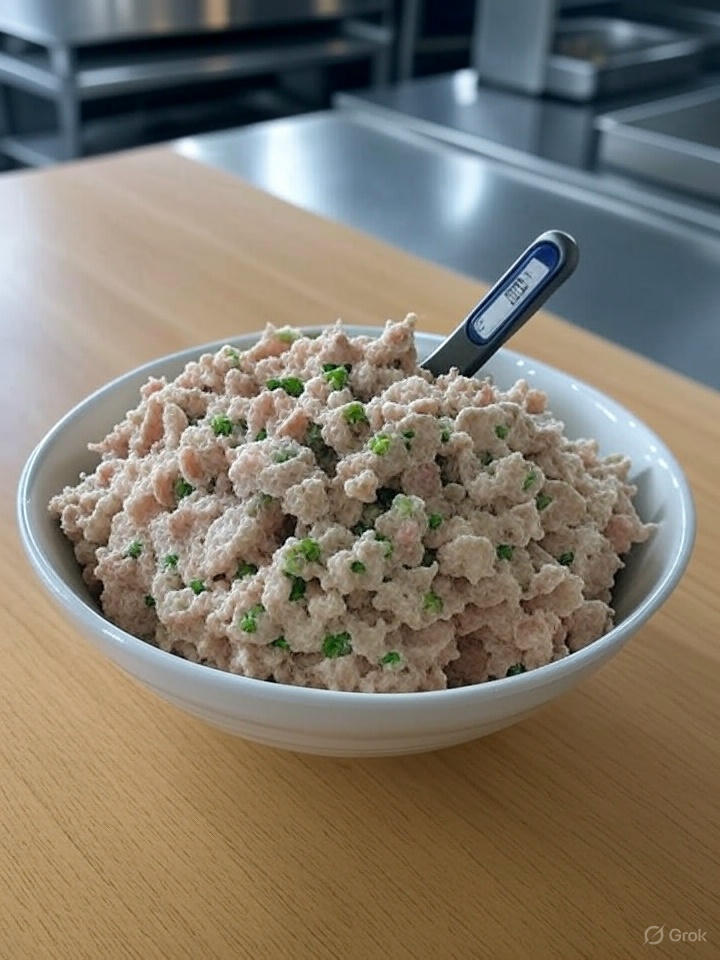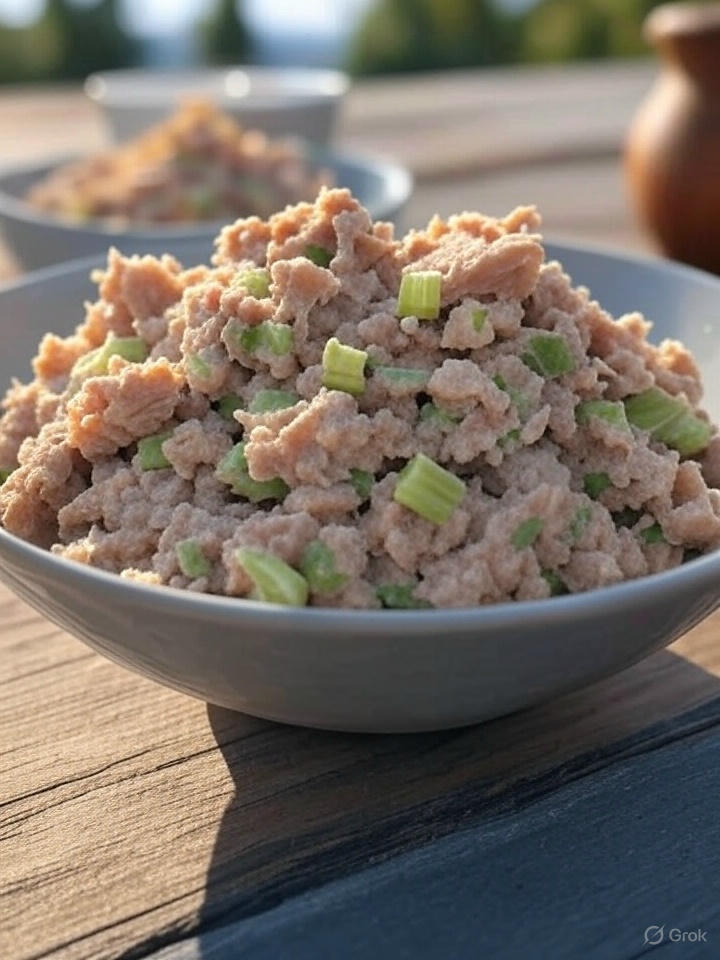Table of Contents
The highest temperature allowed for cold holding tuna salad is 41°F (5°C). This ensures the salad remains safe to eat and prevents bacterial growth.
Food safety is crucial, especially with perishable items like tuna salad. Proper cold holding temperatures help maintain freshness and reduce the risk of foodborne illnesses. Tuna salad, a popular dish, must be kept at or below 41°F (5°C) to ensure it stays safe for consumption.
Understanding and adhering to these temperature guidelines is essential for both home cooks and food service professionals. This post will delve into why this temperature is important, how to monitor it, and tips for maintaining it. Let’s explore the reasons behind this critical food safety rule.

Ideal Temperature Range
Tuna salad is a popular dish enjoyed by many. To keep it safe for eating, it’s important to store it at the right temperature. Cold holding guidelines are essential for maintaining the quality and safety of tuna salad. Understanding the highest temperature allowed for cold holding is crucial. This ensures that your salad remains safe and delicious. Let’s explore the ideal temperature range for tuna salad storage.
Food Safety Standards
Food safety standards are set to ensure that perishable foods like tuna salad remain safe for consumption. These standards are crucial for preventing foodborne illnesses. Here are some important points to consider:
- Cold holding guidelines require tuna salad to be stored at a specific temperature.
- The highest safe temperature for cold holding tuna salad is 41°F (5°C).
- Exceeding this temperature increases the risk of bacterial growth.
- Safe food handling practices are essential to maintain the quality and safety of tuna salad.
According to food safety regulations, maintaining the correct temperature is vital. This helps in preserving the freshness and extending the tuna salad shelf life. By adhering to these standards, you can ensure that your tuna salad remains safe and enjoyable for everyone.
Also Read: Subway Tuna Recipe: Create the Perfect Copycat Sandwich
Recommended Storage Temperatures
Proper storage temperatures are key to keeping tuna salad safe. Here are some cold storage recommendations:
| Storage Type | Recommended Temperature |
|---|---|
| Refrigerator | 34°F to 38°F (1°C to 3°C) |
| Cold Holding | Up to 41°F (5°C) |
It’s important to monitor the temperature regularly. Use a reliable thermometer to check the temperature of your refrigerator. This ensures that your tuna salad stays within the recommended refrigeration temperature.
Temperature control for salads is essential for food safety. Keeping the tuna salad at the right temperature prevents the growth of harmful bacteria. This is especially important for perishable food safety. By following the recommended storage temperatures, you can enjoy your tuna salad without any worries.
Effects Of Temperature On Tuna Salad

Introduction paragraph about What is the Highest Temperature Allowed for Cold Holding Tuna Salad and Effects of Temperature on Tuna Salad…
Tuna salad is a popular dish. It’s important to store it properly to prevent bacterial growth and keep it fresh. The highest safe temperature for cold holding tuna salad is 41°F (5°C). Temperatures above this can cause spoilage and foodborne illnesses. Let’s discuss how temperature affects tuna salad.
Bacterial Growth Risks
Bacterial contamination risks increase when tuna salad is stored at improper temperatures. Refrigeration temperature requirements are crucial to minimize these risks. Cold holding guidelines state that tuna salad should be kept at or below 41°F (5°C). This is to prevent bacteria such as Salmonella and E. coli from multiplying.
Bacteria grow rapidly between 40°F and 140°F. This range is known as the “danger zone.” To ensure perishable food safety, always follow optimal storage conditions. Below are some key points to remember:
- Keep tuna salad at or below 41°F (5°C)
- Check the temperature regularly
- Store in a clean, covered container
- Avoid leaving tuna salad out for more than 2 hours
Maintaining the right temperature can significantly reduce bacterial contamination risks. This helps keep the salad safe to eat.
Quality And Freshness Impact
Tuna salad freshness depends on proper storage. Food quality preservation is influenced by temperature. Cold holding guidelines recommend keeping tuna salad at 41°F (5°C) or lower. Higher temperatures can affect the texture and taste.
When tuna salad is stored at the right temperature, it stays fresh longer. Below is a table showing the impact of storage temperatures on tuna salad:
| Storage Temperature | Quality Impact |
|---|---|
| Below 41°F (5°C) | Maintains freshness and quality |
| 41°F – 50°F (5°C – 10°C) | Gradual quality decline |
| Above 50°F (10°C) | Rapid spoilage and loss of freshness |
To ensure tuna salad quality, always store it in a refrigerator. This helps preserve its taste and texture. Remember, following food safety regulations is essential for maintaining food quality.
Read More: 10 Best Sous Vide Torch 2025: Choose The Right Torch
Best Practices For Cold Holding
Tuna salad is a popular dish enjoyed by many. Keeping it fresh and safe is crucial. Highest Temperature Cold Holding Tuna Salad is an important topic. Best Practices For Cold Holding Food ensure that tuna salad remains safe to eat. Proper cold storage methods preserve the taste and quality. Let’s explore safe temperature limits and how to monitor them.
Proper Refrigeration Techniques
Refrigeration is key to Cold Storage Tuna Salad. Maintaining the correct temperature prevents spoilage. Following Refrigeration Guidelines For Tuna Salad keeps it fresh and safe. Here are some tips:
- Keep tuna salad in the fridge at all times.
- Store it at 40°F (4°C) or below.
- Use an airtight container to avoid contamination.
A common mistake is leaving tuna salad out for too long. Safe Temperature For Tuna Salad should be maintained. Food Safety Temperature Limits are crucial. If the temperature rises above 40°F, bacteria can grow. This makes the salad unsafe to eat.
| Temperature | Condition |
|---|---|
| 40°F (4°C) or below | Safe for storage |
| Above 40°F | Unsafe, bacteria may grow |
Monitoring Temperature Regularly
Food Temperature Monitoring is important. Regular checks keep your food safe. Use a reliable thermometer for accurate readings. Here are some steps:
- Check the temperature at least twice a day.
- Record readings to ensure Proper Food Handling Practices.
- Adjust the fridge settings if needed.
Temperature Control For Salads helps prevent spoilage. Tuna Salad Storage Requirements demand careful monitoring. Consistent temperature checks maintain quality. If the temperature fluctuates, food safety is compromised.
Invest in a good thermometer. It provides peace of mind. Best Practices For Cold Holding include regular checks. This ensures the salad stays fresh and healthy.
Signs Of Spoilage

The highest temperature for cold holding tuna salad is crucial for safety. Tuna salad needs to stay at 40°F or lower. This keeps it fresh and prevents foodborne illnesses. Keeping an eye on the signs of spoilage is important too. Let’s explore how to spot these signs.
Visual And Smell Indicators
Detecting spoilage in tuna salad involves visual cues for freshness and a smell test for food safety. Fresh tuna salad should look appealing and moist. Be on the lookout for:
- Color changes: Fresh tuna salad is usually light pink or beige. Spoiled tuna may turn brown or gray.
- Texture changes: Fresh tuna salad is creamy. Spoiled tuna becomes slimy or dry.
- Visible mold: Any green or black spots indicate spoilage.
Using your sense of smell is also key. Fresh tuna salad should have a mild, pleasant aroma. Spoiled tuna salad will have a bad odor. Trust your nose:
- Offensive smell: A sour or ammonia-like smell means it’s spoiled.
- Fishy odor: Tuna should not smell overly fishy.
When To Discard Tuna Salad
Knowing when to throw away tuna salad is essential for foodborne illness prevention. Tuna salad left out above the highest temperature for cold holding, 40°F, should be discarded after 2 hours. Here are some guidelines:
- Proper refrigeration: Store tuna salad at 40°F or lower.
- Check the date: Tuna salad has a short shelf life. Consume within 3 to 5 days if refrigerated properly.
- Always label: Label containers with the date of preparation.
Not following cold holding requirements can lead to spoilage. Be mindful of the highest temperature for cold holding and keep your tuna salad safe.
Frequently Asked Questions
What Is The Highest Temperature For Cold Holding Tuna Salad?
The highest temperature for cold holding tuna salad is 41°F (5°C). This helps prevent bacterial growth and ensures food safety.
Why Is Temperature Control Important For Tuna Salad?
Temperature control is crucial to prevent bacteria growth. Tuna salad must be kept at 41°F (5°C) or below.
How Can I Maintain Proper Temperature For Tuna Salad?
Use a reliable refrigerator and regularly check its temperature. Ensure it stays at 41°F (5°C) or below.
What Happens If Tuna Salad Exceeds 41°f?
If tuna salad exceeds 41°F, bacteria can grow rapidly. This increases the risk of foodborne illness.
Conclusion
Keeping tuna salad safe is essential. Cold holding temperature matters. Maintain it at 41°F (5°C) or below. This prevents bacteria growth. Safe food handling protects health. Always use a reliable thermometer. Check temperatures frequently. Store tuna salad in a cool place.
Refrigerators help keep food fresh. Serve chilled for best quality. Following these steps ensures safe consumption. Prioritize food safety in your kitchen. Enjoy your meals with peace of mind.


